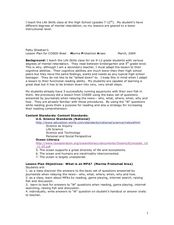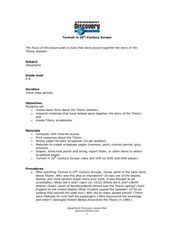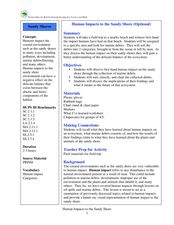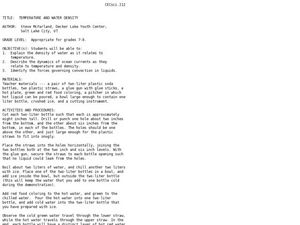Curated OER
Tides & Lunar Cycles
Students demonstrate how the moon affects the tides, a neap tide, and spring tides by using their bodies as models. After students observe the model they created, they draw and label the diagram on a provided worksheet. They then log...
Curated OER
In The Zone
Third graders identify ways that ocean animals grow, survive, reproduce, and adapt. They use computer Internet skills to acces and collect information. They create a PowerPoint presentation. They demonstrate writing skills throughthe...
Curated OER
Marine Protection Areas
Students explain the importance of having Marine Protected Areas. In this ecology lesson, students research MPA's in any of the Great Lakes. They play a MPA simulation game and identify MPA's on the map.
Curated OER
Imagine a Kelp Forest
Students write a story based on their research of the kelp forest. In this ecosystem activity, students view a video and research the kelp forest ecosystem. They write a short story imagining the discovery of a new species in the kelp...
Curated OER
'O'opu Life Cycle
Learners investigate the life cycle of the 'o'opu also known as Hawaiian gobies. In this amphidromous living lesson plan, students discuss the reproductive cycle, create props and an obstacle course to demonstrate the importance of...
Curated OER
Sunken Slave Ship
Learners investigate shipwrecks. In this marine archaeology activity, students create the site of a shipwreck by using a tub filled with sand and items from a "ship". Learners excavate the site and analyze the findings.
Curated OER
The Titanic Disaster
Seventh graders explore the titanic disaster. In this geography instructional activity, 7th graders research basic facts about the Titanic. Students create Titanic scrapbooks.
Curated OER
Oceans-Coral Reefs
Second graders investigate coral reefs. In this oceanology lesson, 2nd graders discuss what constitutes a coral reef and the wildlife that lives there. Students watch a video about coral reefs and take an online quiz.
Curated OER
Make Your Own Compass
Learners explore magnetism. In this "magnets" science lesson plan, students make a compass with common household items and explain the relationship between what a compass does and the earth's magnetic fields.
Curated OER
Submersible Designer
Students work in groups to design, build, and test a submersible prototype. In this engineering lesson, students learn about the importance and design of submersible vessels and apply their knowledge by building one of their own. They...
Curated OER
Jelly Critters
Students compare and contrast three different organisms that are considered gelatinous zooplankton. They describe how they fit into marine food webs.
Curated OER
Getting to the Bottom
Students identify taxa in Arctic benthic communities. They discover organisms that live in these Arctic areas. They analyze data compiled for the Canada Basin Benthic Samples, 2002.
Curated OER
Three Cold Realms
Students identify organisms within the realms of pelagic, benthic and sea ice. They explain how these three interact with each other.
Curated OER
Estuarine Currents
Students explore an estuarine system to gather data on density driven currents. This type of current is contrasted with temperature and wind driven currents.
Curated OER
Lesson Plan on Volcanoes
Fourth graders are able to label a diagram of a volcano with a least 3 of the following parts: the magma chamber, vents, dome, and caldarea. They break up into groups of four and design their own volvanoes using paper and drawing...
Curated OER
Under the Sea
Young scholars identify and interpret that non-fiction books have features like a table of contents, a glossary, and an index, which can efficiently help them find information. They also identify how to narrow the search for information...
Curated OER
Nature Superfish
Young scholars examine the billfish as a predator in the ocean. In this ocean, creatures, and tides lesson, students view video clips and discuss the sea creatures and scientists in the videos. Young scholars create their own videos....
Curated OER
Marine Protected Areas
Students role play different stakeholders perspective on the debate about Channel Islands. In this marine science lesson, students identify different types of Marine Protected Areas. They research about their stakeholder's point of view...
Curated OER
Staying Up
Students will explain the Archimedes's Principle. In this lesson on plankton, students will describe three factors that can affect the buoyancy of plankton. This lesson contains extensive background information, extensions, and multiple...
Curated OER
Living Light
Students explain bioluminescence. In this life science lesson, students discuss bioluminescence and conjure examples of organisms that carry this trait and how it is useful in their environment.
Curated OER
Animals of the Fire Ice
Students examine ocean life by identifying methane hydrates. In this ocean life lesson, students research organisms that live in the coldest, deepest parts of the ocean and live off methane hydrates. Students create a group...
Curated OER
Rocky Shore Food Web Drama
Students explore food chains. In this ecosystem lesson, students discover how plants and animals rely on each other for survival. Students research the rocky shore ecosystem and create a skit representing the ecosystem.
Curated OER
Human Impacts to the Sandy Shore
Students investigate human impact on coastal environments. For this coastal environment lesson, students observe human impact on coastal environments. Students sort, classify, and chart marine debris collected on a local beach.
Curated OER
Temperature and Water Density
Students consider the effects of temperature on water density. For this Earth Science lesson, students evaluate a demonstration of cold and hot water currents in a model. Students use two liter bottles and varied water temperatures with...
Other popular searches
- Oceans
- Oceanography
- Continents and Oceans
- Ocean Currents
- Ocean Mammals
- Ocean Food Chain
- Ocean Explorers
- Ocean Animal Adaptations
- Continents Oceans
- Oceans and Seas
- Ocean Floor
- Oceanography Science























